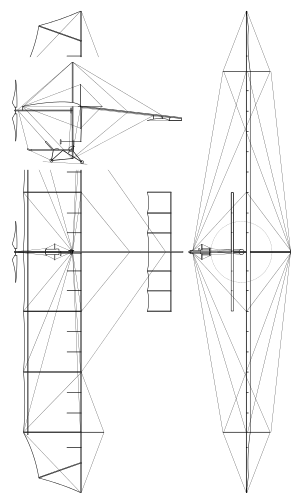Gossamer Condor
| Gossamer Condor | |
|---|---|
 | |
| The Gossamer Condor at the Smithsonian National Air and Space Museum | |
| Role | experimental aircraft |
| National origin | United States |
| Manufacturer | AeroVironment |
| First flight | 1977 |
| Status | On display |
| Number built | 1 |
| Developed into | Gossamer Albatross |
The Gossamer Condor was the first human-powered aircraft capable of controlled and sustained flight; as such, it won the Kremer prize in 1977. It was created by Paul MacCready and Peter Lissaman of AeroVironment, Inc.
Design and development
The Kremer prize had been set up in 1959 by Henry Kremer, a British industrialist, and offered £50,000 in prize money to the first group that could fly a human-powered aircraft over a figure-eight course covering a total of one mile (1.6 kilometers). The course also included a ten-foot pole that the aircraft had to fly over at the start and at the end. Early attempts to build human-powered aircraft had focused on wooden designs, which proved too heavy. Very early attempts – notably the HV-1 Mufli (de) and Pedaliante – used catapult launches.[1]
In 1961, Southampton University's Man Powered Aircraft SUMPAC took to the air at Lasham Airfield on 9 November, piloted by Derek Piggott, achieving a maximum flight of 650 metres. One week later, on 16 November, the Hatfield Puffin flew, and eventually managed a maximum flight of 908 metres but it was difficult to turn. The Jupiter managed 1,239 m in June 1972. The Nihon Stork B achieved over two kilometers in 1976.[2]
In the early 1970s, Dr Paul B. MacCready and Dr Peter B. S. Lissaman, both of AeroVironment Inc., took a fresh look at the challenge and came up with an unorthodox aircraft, the Gossamer Condor. He took his inspiration from hang gliders, increasing wing area so that the drag of the wire bracing needed would be reduced.[3] The Gossamer Condor is built around a large wing with a gondola for the pilot underneath and a canard control surface on a fuselage extension in front, and is mostly built of lightweight plastics with aluminum spars.[4]
The Gossamer Condor evolved over a period of time through three distinct versions. The first version, known by MacCready as the Pasadena version, was a proof-of-concept aircraft which flew only once in the parking lot of the Rose Bowl in Pasadena. The first aircraft carrying the name Gossamer Condor was known as the Mojave Version, without pilot fairings and other niceties, flown at Mojave airport by MacCready's sons on 26 Dec 1976. The record-breaking version, known as the Shafter version included all the improvements such as a pilot nacelle and double-skin airfoil sections, allowing the aircraft to fly long distances as well as maneuver.
The aircraft, piloted by amateur cyclist and hang-glider pilot Bryan Allen, won the first Kremer prize on August 23, 1977 by completing a figure-eight course specified by the Royal Aeronautical Society, at Minter Field in Shafter, California. It was capable of taking off under human power.
The aircraft is preserved at the Smithsonian National Air and Space Museum.
The success led Paul MacCready and AeroVironment to carry on with experimental aircraft:
- the Gossamer Albatross, which crossed the English Channel,
- the Solar Challenger, a solar electric-powered version that also made an English Channel crossing,
- NASA's Pathfinder/Helios series of unmanned solar-powered aircraft.[4]
Specifications (Gossamer Condor)

General characteristics
- Crew: one
- Length: 30 ft 0 in (9.14 m)
- Wingspan: 96 ft 0 in (29.25 m)
- Height: 18 ft 0 in (5.49 m)
- Empty weight: 70 lb (31.75 kg)
- Powerplant: 1 × Bryan Allen
See also
- The Flight of the Gossamer Condor, a 1979 short documentary film
- Related development
- Aircraft of comparable role, configuration and era
References
- ↑ Grosser, Morton (1981). Gossamer Odyssey: The Triumph of Human-Powered Flight. Houghton Mifflin. ISBN 0-7603-2051-9.
- ↑ History – © 2009 Royal Aeronautical Society
- ↑ Gossamers
- ↑ 4.0 4.1 "SOLAR-POWERED UAVS: HALSOL & SOLAR HAPP", The Prehistory Of Endurance UAVs, by Greg Goebel, in the Public Domain
Further reading
- Morton Grosser. Gossamer Odyssey: The Triumph of Human-Powered Flight. MBI Press, 2004; Dover Publications, Inc., 1991; Houghton Mifflin Co., 1981
- Morton Grosser. On Gossamer Wings. York Custom Graphics, 1982
- Gosnell, Mariana. Zero Three Bravo. Alfred A. Knopf, Inc., 1993. (see chapter entitled Shafter)
External links
| Wikimedia Commons has media related to Gossamer Condor. |
- Condor at the Smithsonian
- Site with an expanding photo archive of Gossamer-series aircraft, by the Gossamer Albatross team photographer
- THE FLIGHT OF THE GOSSAMER CONDOR DVD. Re-mastered & digitally restored in 2007 from a new Academy Film Archive preservation print. Won the Academy Award in 1978 for best Documentary Short Subject.
- Paul MacCready talking at TED
| ||||||||||||||||||||
| ||||||||||||||||||||||